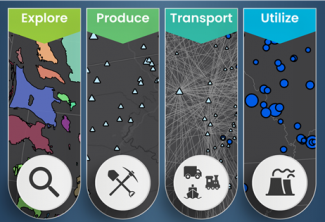Through developing robust domestic sources of critical materials (CMs), including rare earth elements (REEs), America’s historic energy producing regions, such as the Powder River Basin and others, have a unique opportunity to solve one of the nation’s greatest resource challenges and benefit their workers in the process. How this can be achieved was detailed by NETL with leaders of industry and academia at the International Meeting for Applied Geoscience & Energy (IMAGE) in Houston, Texas and the Powder River Basin CORE-CM Annual Forum in Gillette, Wyoming.
Kelly Rose, Ph.D., technical director for NETL's Science-based AI/ML Institute (SAMI), represented the Lab at these events, which sought to share the latest technological developments and emerging best practices needed establish new, unconventional resources for CMs in American geological formations.
CMs, which are essential for modern electronics, medicine, energy components, defense technologies, and consumer products, are abundant in Earth’s crust but dispersed in low concentrations, making them prohibitively expensive to mine. Basically, if rock and soil constitute a haystack, then the CMs are the valuable needles. However, SAMI-affiliated researchers are developing new tools — applying principles of Big Data and artificial intelligence used in other facets of the economy — to better locate these needles in the haystack. These innovations help in prospecting for REEs and characterizing the deposits of individual elements so they can be collected in large enough quantities to be profitable.
Furthermore, places rich in deposits of coal and coal byproducts, such as the Powder River Basin in Wyoming and Montana, are potential gold mines as unconventional sources of REEs because they can be extracted from coal and byproducts of mining it. As efforts to decarbonize the U.S. power sector and economy move forward, more REEs and CMs will be needed for the production of electric vehicle engines, turbines for windmills, batteries for energy storage, solar power components, hydrogen power-oriented infrastructures and other applications.
This transition may not be limited to the renewable energy sector itself. The AAPG-IMAGE panelists and the CORE-CM workshop attendees envisioned a workforce transition as well, in which today’s hydrocarbon and petrochemical workers all over the country could also have prosperous futures in new industries around the extraction of unconventional REEs.
“This is an exciting time because we’re entering new territory,” Rose said. “The Powder River Basin has been a cornerstone of our country’s energy production for more than a century, and even as we seek to decarbonize our economy, the Powder River Basin can still play a vital role as an unconventional source of the resources we need. At IMAGE, we detailed how these big data concepts and technologies can be applied to other energy-producing regions around the country, enabling all of them to help develop a domestic REE and CM supply chain.”
Currently, America’s supplies of REEs and CMs are imported, making them vulnerable to disruptions in global trade during events like the COVID-19 pandemic. To ensure continued supplies of these vital resources, NETL has worked for years to develop new sources of these vital resources.
The Office of Fossil Energy and Carbon Management’s Minerals Sustainability Program and NETL have scheduled another conference Oct. 25-27 in Pittsburgh, Pennsylvania. The Resource Sustainability Project Review Meeting will bring together experts spanning the full spectrum of REE and CM development, not just accessing the resources themselves, but also those with knowledge in CM/REE separations, processing, supply chain and more.
Ultimately, this program is seeking to establish a brand-new resource base for the U.S. and the world to accelerate and meet the growing demands of the clean energy transition.
NETL is a U.S. Department of Energy national laboratory that drives innovation and delivers technological solutions for an environmentally sustainable and prosperous energy future. By leveraging its world-class talent and research facilities, NETL is ensuring affordable, abundant and reliable energy that drives a robust economy and national security, while developing technologies to manage carbon across the full life cycle, enabling environmental sustainability for all Americans.




